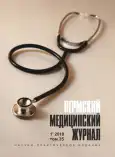Retrospective analysis of events of death at home among patients under follow-up observation
- Authors: Sandakov Y.P.1
-
Affiliations:
- Diagnostic Center № 3 of Moscow Healthcare Department
- Issue: Vol 35, No 1 (2018)
- Pages: 68-74
- Section: Articles
- URL: https://journals.rcsi.science/PMJ/article/view/8672
- DOI: https://doi.org/10.17816/pmj35168-74
- ID: 8672
Cite item
Full Text
Abstract
Aim. To study the peculiarities of asking for medical care by patients from among those dead at home, who had been under follow-up observation.
Materials and methods. The data, received from ambulatory medical records of 100 dead at home patients with follow-up, were analyzed using the methods of descriptive and inductive statistics.
Results. A mean age of death was 74.9 ± 13.4 years, men – 65.8 ± 14.1 years, women – 79.2 ± 10.9 years. Cardiovascular diseases were the cause of follow-up observation in 78 % of cases and the cause of death in 85 %; in 30 % of patients the disease was detected while carrying out prophylactic medical examination. A mean duration of disease by the moment of death was 13.0 ± 8.0 years, among pensioners 13.7 ± 8.5 years, in able-bodied persons 9.6 ± 4.3 years. A mean duration of follow-up observation was 9.2 ± 5.8 years. An average number of planned visits was 2.8 ± 0.89, but the number of real visits during the last year of follow-up observation was 2.4 ± 1.2. Disability was registered in 77.6 % of patients, concomitant diseases – in all patients. For the last year, exacerbations were recorded in 92 % of patients, emergency calls – in 80 %, hospitalization events – 52 %, including 55.8 % – urgent ones.
Conclusions. The absence of significant difference regarding the duration of disease between pensioners and able-bodied patients (т = 0.16, р = 1.43) as well as the absence of correlation between the age and duration of disease (χ2 = 0.19, p = 0.2) indirectly prove the influence of duration of disease on its outcome, but not the age. Attendance, characterizing clinical loyalty to treatment, does not depend on age (χ2 = –0.19, р = 0.18), sex (т = 1.0, р = 0.32), way of detecting disease (f = 0.9, p = 0.4), class of main disease (f = 0.91, p = 0.44), duration of disease (χ2 = –0.13, р = 0.49), exacerbations (χ2 = –0.17, р = 0.24), concomitant diseases (χ2 = 0.006, р = 0.9). The number of emergency calls, hospitalizations, urgent hospitalizations does not depend on duration of follow-up observation, regularity and number of real visits to a doctor (p > 0.05) that indicates unsatisfactory quality of follow-up observation.
Keywords
Full Text
##article.viewOnOriginalSite##About the authors
Ya. P. Sandakov
Diagnostic Center № 3 of Moscow Healthcare Department
Author for correspondence.
Email: Sand_2004@mail.ru
кандидат медицинских наук, заместитель главного врача по медицинской части
Russian Federation, MoscowReferences
- Гадаборшев М.И., Левкович М.М., Рудлицкая Н.В. Организация оценки эффективности первичной медицинской помощи. М.: ИНФРА-М 2013; 424.
- Гасанова А.З. Медико-организацион ные и социально-экономические аспекты диспансеризации работающего городского населения: автореф. дис. … канд. мед. наук. М. 2012; 26.
- Диспансерное наблюдение больных хроническими неинфекционными заболеваниями и пациентов с высоким риском их развития: метод. рекомендации. Под ред. С.А. Бойцова и А.Г. Чучалина. М.: РОПИЗ 2014; 112.
- Королева Т.А. Научное обоснование совершенствования поликлинического диспансерного учета хронических неинфекционных заболеваний у лиц трудоспособного возраста: автореф. дис. ... канд. мед. наук. М. 2010; 24.
- Кочубей А.В., Ластовецкий А.Г., Цветкова Е.А. Особенности нормативного правового регулирования организации профилактической помощи при реализации программ государственных гарантий оказания бесплатной медицинской помощи. Вестник Росздравнадзора 2015; 3: 64–66.
- Овод А.И., Солянина В.А. Результаты исследования обращаемости женщин трудоспособного возраста за профилактической помощью. Возраст-ассоциированные и гендерные особенности здоровья и болезни: сб. материалов междунар. науч.-практ. конф. Курский гос. мед. ун-т. Курск 2016; 244–253.
- Стародубов В.И., Калининская А.А., Сон И.М., Щепин В.О. Первичная медико-санитарная помощь: механизмы совершенствования. Вена: East West Association for Advanced Studies and Higher Education GmbH 2016; 118.
- Linn A.J., Vervloet M., van Dijk L., Smit E.G., Van Weert J.M. Effects of health interventions on medication adherence: a systematic review of the literature. J Med Internet Res 2011; 13(4), available at: https://www.ncbi.nlm.nih.gov/ pmc/articles/PMC3278089
- Viswanathan M., Golin C., Jones C., Ashok M., Blalock S., Wines R. et al. Interventions to improve adherence to self-administered medications for chronic diseases in the United States: a systematic review. Ann Intern Med 2012; 157 (11): 785–795.
Supplementary files






